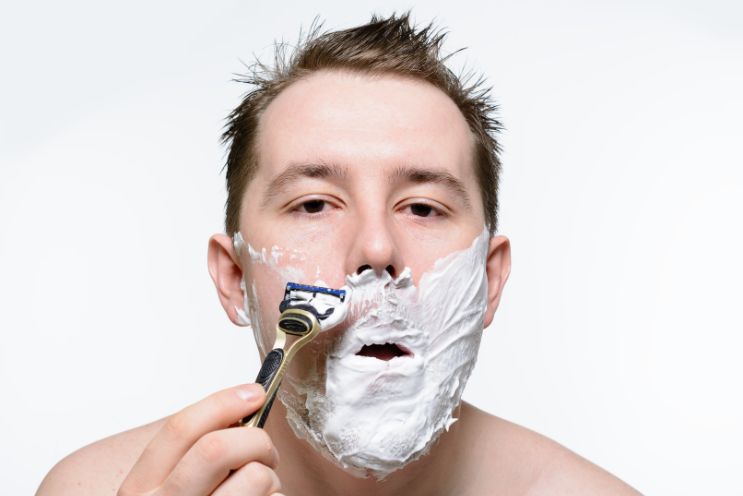Table of Contents
ToggleOverview
Razor burns and razor bumps both sound the same and are caused for the same reasons, the only difference is how they appear on the topical surface of the skin. Razor burns are small red bulgings, while razor bumps are more like pimples, often filled with pus. Both have different treatment options. It’s important to note that you can relieve the symptoms of razor burns overnight, but treatment for razor bumps is not possible overnight, and it will take a proper diagnosis as well as a prescription for complete eradication.
What is the difference between razor bumps and burns?
A keen self-care is considered incomplete without shaving unwanted hair, either by using a razor, laser, or waxing, but isn’t it quite unfortunate to see the strawberry legs right after a day or two when you use a razor?
Let’s Understand what complications razors can bring besides strawberry legs, especially Razor bumps and burns.
Razor burns are red and itchy, bulging surfaces easily noticeable on the area where razors are used right after use, whilst razor bumps are also the bulging surfaces from the surface, with the only difference being resembling pimples. They can often get filled with pus and become sore.
As per the Research, “Pseudofolliculitis barbae (PFB) is a chronic inflammatory disorder of follicular and perifollicular skin characterized by papules, pustules, and post-inflammatory hyperpigmentation.”
See the table below to get a better understanding of the difference.
| RAZOR BURNS | RAZOR BUMPS |
| Appear as red, small, and itchy surfaces | Appear as red, itchy, painful |
| Symptoms include Itching and burning sensation. | Symptoms are: Infected and filled with pus. |
| Cause: Shaved hair regrows and curls back into the skin. | Cause: Friction and irritation from shaving |
Remedies for Razor Burns and Razor Bumps
Certain medical treatments as well as home remedies, can work for the betterment of razor burns or bumps.
Let’s discuss all of them.
For Razor Burns
- Cool Compression: Cool compression is one of the most prescribed and easy-to-use options for instant relief from burning and itching, says Dr.Richard Honaker, M.D. It’s good to seek medical attention if it persists.
- Moisturizing the Area: Use a gentle, alcohol-free moisturizer to keep the skin hydrated and alleviate dryness caused by shaving. Dry skin generally increases friction and makes it easy for the razor blades to affect the skin. Shaving foams and creams are easily available to add moisture to the skin before shaving.
- Avoid Irritants: Avoid using products with harsh chemicals or fragrances that could further irritate the skin. It’s good to keep your skincare products free of any irritants. Exposing your skin to harmful chemicals decreases the skin’s capability to deal with aging wrinkles and irritants.
- Topical Creams: Over-the-counter hydrocortisone creams can help reduce inflammation and itching. Salicylic acid is also available and prescribed by healthcare providers for the purpose of healing skin.
- Aloe Vera Gel: Applying aloe vera gel directly on the affected area can provide a cooling effect and help calm irritated skin as well as irritation. Aloe vera can naturally soothe and calm the affected skin, along with hydration. It’s widely prescribed as a skin hydrating agent by dermatologists as well.
- Avoid Shaving: It’s not good to expose your skin again to the harmful razor that has already affected your skin. Give your skin a break from shaving until the irritation subsides. Resume shaving only when your skin is completely healed and moisturized.
- Proper Shaving Technique: When you resume shaving, ensure you use a sharp blade, as showering from a blade that is not sharp enough can irritate the skin again. Use a shaving cream or gel, and shave toward hair growth.
- Exfoliation: Gently exfoliate the area a day before shaving to remove dead skin cells and prevent ingrown hairs. Topical exfoliating salicylic acid scrubs are good to go when you are thinking of starting shaving once again, as it will not only remove the dead cells but will give the skin some time to heal.
For Razor Bumps
- Warm Compression: Warm compression with warm packs or cloth will give a soothing effect to the painful shaved area. It will work as an instant relief for the razor bumps.
- Topical Antibiotics: Antibiotics are used for the pus-filled infection caused after shaving called Razor burns, e.g., Topical Clindamycin and hydrocortisone 1% as an effective treatment option. Make sure you follow a prescribed regimen and frequency for complete eradication and treatment of Razor bumps.
- Oral Antibiotics: Oral Antibiotics like Doxycycline tablets (50 -100 mg 2 times daily) and Erythromycin Tablets (250 mg 4 times daily). It’s good to consult your healthcare provider for the correct antibiotic prescription. Says Dr. Richard Honaker, M.D.
- Topical Retinoids: Consult a dermatologist or healthcare provider for a prescription strength of retinoid creams, which can help prevent ingrown hairs after shaving. It will be prescribed to use retinoid creams twice a week and start with a lower frequency as they might harm your skin if started with a higher frequency. It’s crucial to avoid sunlight exposure to the skin after using retinoids.
- Salicylic Acid for Razor Bumps: It is a Beta hydroxy acid (BHA) and is commonly used in skincare products due to its exfoliating and anti-inflammatory properties. Mostly, 1-2% preparations are available for razor bumps and nodular pimples, as per Richard Honaker, M.D
How long do razor bumps take to go away?
Razor bumps will only go if the prescribed medication, dose, and frequency properly treat them. It is also highly dependent on the body’s healing process, If the healing is taking time, it’s good to wait till your skin is completely healed and ready for any other topical procedure.
As per the National Institute of Health, “Stopping shaving usually ceases its occurrence over a period of 12 weeks.
Adding Zinc Supplements to your diet will enhance or increase the skin’s wound healing, increasing protein synthesis.
If we classify according to the severity of the Razor bumps:
- Mild cases: Will go away completely in 1 to 2 weeks.
- Moderate Cases: If the razor bumps are more persistent or numerous, they might take a couple of weeks to a month to fully resolve.
- Severe Cases: In more severe cases, where razor bumps are deeply ingrown or become infected, the skin might take several weeks or even a few months to heal fully.
Razor bumps on different skin tones
Razor bumps can affect people with all skin tones presenting with the same causes. The only difference is that they will appear different on different tones due to the contrast issue of the skin tones.
Razor bumps can appear on your light skin tones as small red or pink bumps around the hair follicles while on medium skin tones, they can be slightly darker than the surrounding skin.
Darker skin tones are more prone to developing post-inflammatory hyperpigmentation (PIH) due to razor bumps. PIH is a common cutaneous disorder that occurs mainly after any skin trauma or injury.
According to an independent study conducted in the military where a clean-shaven policy exists, earlier reports gave a prevalence of 45%–83% among black recruits and soldiers in the US Army, with fewer occurrences in white soldiers.
Risk Factors
Risk factors, in general, are the factors that can play a role in affecting your health badly. Some factors are:
- Age: Age is a contributing factor to health. As far as razor bumps are concerned, they can occur mainly after puberty, when hair growth and shaving processes start. As per the research published, it’s evident that “Puberty marks the beginning of this condition, during which secondary sexual hairs like facial, axillary, pubic, and chest hair start to grow significantly.
- Hair Type: Curly or coarse hair is more prone to becoming ingrown after shaving, leading to razor bumps. Curly hair can easily curl back into the skin, causing inflammation. Fine and thin hair is less likely to cause razor bumps.
- Shaving Process: The equipment you use and how you do it affects the process and skin greatly, for instance, using a razor with double blades will affect the skin, producing more friction. Similarly, shaving should be done in the direction of the hair, not in the opposite direction, as it might break the hair while shaving in between.
Shaving rigorously is not beneficial for the skin as it increases the chance of skin injury. “ Dry shaving with razors should be discouraged as it produces sharp, beveled hair tips aiding penetration into the skin
When to Consult a Doctor
Do you think that your acne, shave bumps or folliculitis? Why not chat with one of our medical doctors to get a second opinion or to find out how to fix razor bumps or bumps on your face after shaving?
Folliculitis is often misdiagnosed. In extreme cases can result in permanent hair loss. All it takes is a few minutes to put you in touch with a medical professional and put your mind at ease.
Consult with our doctor at Your Doctors Online account now!
FAQs About Razor Bumps Answered by Your Doctors Online
No, Neosporin (Over-the-counter Antibiotic) is generally not the choice of drug for razor bumps. Salicylic acid, along with glycolic acid products in the form of topical creams or exfoliants, will help razor bumps go early.
As per the National Institute of Health, “Cessation of shaving usually stops its occurrence over a period of 12 weeks”. However, It also depends on the healing process of your body. They will last for 2-3 weeks, and Usually, it will take 8-10 days for normal healing. It’s good to get yourself checked by your healthcare provider.
It is because it either is not treated properly as well as diagnosis or you didn’t stop the shaving. It’s good to get a consultation for the once and for all solution as well as a prescription for your razor bumps.







